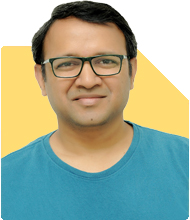Ramalingam Kalirajan |10899 Answers |Ask -Follow
Mutual Funds, Financial Planning Expert - Answered on Jun 28, 2024
He has an MBA in finance from the University of Madras and is a certified financial planner.
He is the director and chief financial planner at Holistic Investment, a Chennai-based firm that offers financial planning and wealth management advice.... more

Good morning I am 34 & invesying 40000 per month into SIP and 12.5k into NPS for the last two years. I am hoping to continue my professional career for atleast another 24 years. My current expenses are around 80k, so keeping in my the inflation too, could I build a corpus to withdraw the amount adjusted to inflation after my retirement with these investments?
Current Financial Situation
You are 34 years old and plan to work for another 24 years. You currently invest Rs 40,000 per month in SIPs and Rs 12,500 per month in NPS. Your monthly expenses are around Rs 80,000. To build a corpus that allows you to withdraw an inflation-adjusted amount after retirement, we need to consider several factors.
Firstly, I want to compliment you on your foresight and proactive approach to financial planning. Consistently investing in SIPs and NPS shows a solid understanding of long-term financial growth. Your current savings strategy is impressive and sets a strong foundation for your future.
Understanding Inflation
Inflation erodes the purchasing power of money over time. What Rs 80,000 buys today will cost more in the future. Assuming an average inflation rate of 6-7%, we can estimate the future value of your current expenses. This helps us understand the corpus needed to maintain your current lifestyle post-retirement.
Investment Growth Potential
SIPs in mutual funds typically offer good returns over the long term, averaging around 12-15% annually. NPS, being a mix of equity and debt, might yield slightly lower returns, averaging around 8-10%. These returns are not guaranteed but are reasonable estimates based on historical performance.
Projected Corpus Calculation
Let's assume you continue investing Rs 40,000 in SIPs and Rs 12,500 in NPS for the next 24 years. The power of compounding will significantly grow your investments. We need to estimate the total corpus accumulated by the time you retire and then assess if it will meet your post-retirement needs.
Assessing Future Expenses
Your current monthly expenses are Rs 80,000. Considering inflation, these expenses will increase over time. To maintain your lifestyle, you will need a larger amount each month in the future. We can calculate the future value of your current expenses using the average inflation rate. This gives us a target monthly withdrawal amount for your retirement years.
Analyzing SIP Contributions
Your SIP contributions are a crucial part of your investment strategy. Over 24 years, consistent SIP investments can grow significantly due to compounding. The key is to remain consistent and avoid withdrawing from these investments prematurely. This disciplined approach maximizes the growth potential of your investments.
Evaluating NPS Contributions
NPS is a good retirement planning tool as it provides an additional source of retirement income. The contributions made to NPS can grow over time, providing you with a pension corpus upon retirement. The partial withdrawal option before retirement and tax benefits make it a valuable addition to your portfolio.
Balancing Risk and Return
Your current investment strategy involves SIPs and NPS, which are diversified investment options. SIPs primarily focus on equity, which has higher returns but also higher risk. NPS, being a mix of equity and debt, balances the portfolio by reducing overall risk. This balanced approach is crucial for long-term financial stability.
Monitoring and Rebalancing
It's essential to regularly review and rebalance your investment portfolio. Market conditions and personal circumstances change over time. A yearly review with a Certified Financial Planner can help ensure your investments remain aligned with your goals. Adjustments may be needed to optimize your portfolio's performance.
Emergency Fund and Insurance
While building your retirement corpus, don't forget the importance of an emergency fund. Having 6-12 months of expenses saved in a liquid fund can provide a financial cushion during unexpected situations. Additionally, adequate health and life insurance coverage is crucial to protect your family’s financial future.
Long-Term Investment Strategy
A successful long-term investment strategy involves staying invested, being patient, and avoiding panic during market volatility. Stick to your SIPs and NPS contributions regardless of short-term market fluctuations. The power of compounding works best when investments are left to grow over time.
Disadvantages of Index Funds
Index funds may seem attractive due to their lower expense ratios, but they merely track the market. They do not offer the potential for higher returns that actively managed funds can provide. Actively managed funds have fund managers who make strategic decisions to outperform the market.
Disadvantages of Direct Funds
Direct funds have lower expense ratios but require more active management and market knowledge. Investing through a Mutual Fund Distributor (MFD) with CFP credentials provides expert guidance. This helps optimize your portfolio and navigate complex market conditions effectively.
Avoiding Common Pitfalls
Common investment mistakes include withdrawing investments prematurely, lack of diversification, and not accounting for inflation. Avoid these pitfalls by sticking to your investment plan, diversifying your portfolio, and regularly reviewing your financial plan. Seek professional advice when needed to stay on track.
Benefits of Regular Funds
Investing in regular funds through an MFD with CFP credentials offers several benefits. These include expert advice, portfolio management, and better market understanding. The slightly higher expense ratio is justified by the potential for higher returns and professional guidance.
Importance of Financial Discipline
Financial discipline is crucial for long-term success. Continue your monthly SIPs and NPS contributions without interruption. Avoid unnecessary expenses and focus on saving and investing consistently. This disciplined approach will help you achieve your financial goals.
Retirement Corpus Goal
Based on your current investments and future expenses, we need to calculate the retirement corpus goal. This involves estimating the total amount needed to sustain your lifestyle post-retirement, considering inflation and life expectancy. A Certified Financial Planner can help you with these detailed calculations.
Future Income Streams
In addition to SIPs and NPS, consider other potential income streams during retirement. These could include a part-time job, consulting, or freelance work. Diversifying your income sources can provide additional financial security during your retirement years.
Final Insights
Your proactive approach to saving and investing is commendable. By continuing your disciplined investment strategy and making necessary adjustments, you can build a substantial retirement corpus. Regularly review your financial plan, seek professional advice, and stay committed to your goals. With careful planning and consistency, you can achieve a comfortable and financially secure retirement.
Best Regards,
K. Ramalingam, MBA, CFP,
Chief Financial Planner,
www.holisticinvestment.in
You may like to see similar questions and answers below
Ramalingam Kalirajan |10899 Answers |Ask -Follow
Mutual Funds, Financial Planning Expert - Answered on May 07, 2024
Ramalingam Kalirajan |10899 Answers |Ask -Follow
Mutual Funds, Financial Planning Expert - Answered on Feb 03, 2025
Ramalingam Kalirajan |10899 Answers |Ask -Follow
Mutual Funds, Financial Planning Expert - Answered on Sep 04, 2025
Reetika Sharma |425 Answers |Ask -Follow
Financial Planner, MF and Insurance Expert - Answered on Nov 13, 2025
Ramalingam Kalirajan |10899 Answers |Ask -Follow
Mutual Funds, Financial Planning Expert - Answered on Dec 17, 2025
Ramalingam Kalirajan |10899 Answers |Ask -Follow
Mutual Funds, Financial Planning Expert - Answered on Dec 17, 2025
Ramalingam Kalirajan |10899 Answers |Ask -Follow
Mutual Funds, Financial Planning Expert - Answered on Dec 17, 2025
Ramalingam Kalirajan |10899 Answers |Ask -Follow
Mutual Funds, Financial Planning Expert - Answered on Dec 17, 2025
Ramalingam Kalirajan |10899 Answers |Ask -Follow
Mutual Funds, Financial Planning Expert - Answered on Dec 17, 2025
Mayank Chandel |2576 Answers |Ask -Follow
IIT-JEE, NEET-UG, SAT, CLAT, CA, CS Exam Expert - Answered on Dec 17, 2025
Radheshyam Zanwar |6747 Answers |Ask -Follow
MHT-CET, IIT-JEE, NEET-UG Expert - Answered on Dec 16, 2025
Shalini Singh |181 Answers |Ask -Follow
Dating Coach - Answered on Dec 16, 2025
Patrick Dsouza |1429 Answers |Ask -Follow
CAT, XAT, CMAT, CET Expert - Answered on Dec 16, 2025
Nayagam P P |10858 Answers |Ask -Follow
Career Counsellor - Answered on Dec 16, 2025
























